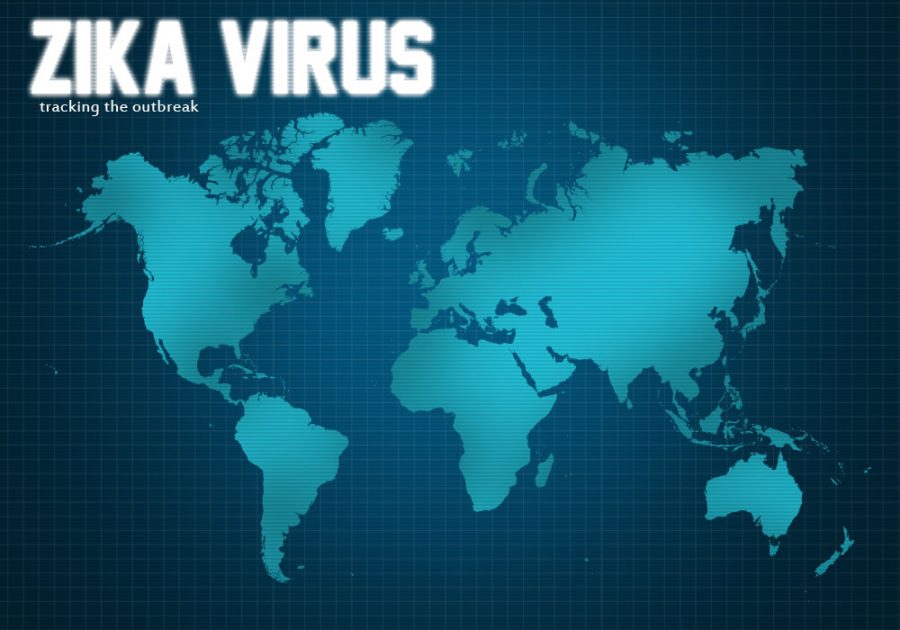A new pandemic called the Zika Virus is quickly taking hold of and infecting many countries in the West, and the United States seems to be next on the list. The virus, a disease spread through mosquito bites with moderate symptoms of red eyes, fever, rash and joint pain according to the Centers for Disease Control and Prevention. One case of the virus in Texas was even transmitted sexually.
While that might not sound like something to worry about, the virus can cause birth defects in babies whose mothers become infected during pregnancy and is associated with Guillain-Barré syndrome, a condition that can lead to body paralysis. The most common birth defect caused by the Zika virus is microcephaly, which is associated with small heads and underdeveloped brains in newborns, according to vox.com.
Pockets of the disease have already emerged in Mexico, Central and South America, as well as Thailand and many South Pacific Islands. In the United States, 50 cases of the virus have been reported in 13 states, all of them carried by returning travelers from Latin America.
Although the virus is a huge topic of concern for highly affected areas, sophomore Kris Cho said as an American, it isn’t that big of a deal for a country in which very few people are going to be traveling to countries like Brazil. She believes efforts surrounding the Zika virus are better spent in areas that are in the thick of it.
“I think a terrified public reaction like the one that was similar to the Ebola epidemic would be better to avoid and is unnecessary within the United States,” Cho said. “Worry for us Americans is better directed at the people who cannot get the proper health care and are at a much higher risk for the virus.”
The virus’s sudden and highly impactful uprising is similar to that of the Ebola virus in 2014, but William Roland, a professor of clinical medicine at the University of Missouri- Columbia (UM), said that unlike Ebola, which is usually fatal, most people fully recover from Guillain-Barré syndrome. However, microcephaly and fetal loss are major consequences for women of childbearing age in endemic areas because they are now faced with the question of whether to delay having children or move out of the endemic area to have them.
Also a professor of clinical medicine at UM, Christian Rojas-Moreno distinguished Ebola as more hazardous than Zika because Ebola has a mortality rate of up to 40 percent, while Zika is generally mild or asymptomatic; approximately one in five victims develop symptoms.
“Ebola can be transmitted from person to person whereas Zika requires a vector — the Aedes mosquito,” Rojas-Moreno said. “We are still studying the long-term effects of Ebola in survivors. There is an urgent need for research to confirm the link between Zika and Guillain-Barré or microcephaly.”
Because the United States mainland has Aedes species mosquitoes that can become infected and spread the Zika virus, Roland does think it has the potential to affect the United States.
“With the recent outbreaks, the number of Zika virus disease cases among travelers visiting or returning to the United States will likely increase,” Roland said. “These imported cases may result in local spread of the virus in some areas of the United States.”
Chair of the RBHS science department and anatomy teacher Melissa Wessel is concerned about the Zika virus spreading to the midwestern United States, especially if there are more cases transmitted sexually. Cho thinks the new information might add onto the political discussion and cultural connotation surrounding STDs, and she sees it as another reason to push for more thorough sex education.
“At this point, all we can do is control the mosquitoes and prevent mosquito bites. We can’t do better than that,” Wessel said. “Overall, those countries with well-developed science communities haven’t suffered greatly from mosquito-borne illnesses and have thus spent more time/money on researching and treating other types of diseases.”
Roland is proud that the U.S. is trying to help treat and prevent the disease in affected areas through the CDCs. Methods to help stop the spread of the disease include mosquito control, education and the development vaccines as well as rapid diagnostic tests. He believes that once an active case is identified, taking measures to keep that case from being bitten by mosquitoes for the first week of the illness is crucial in order to prevent the mosquito from contracting it. He doesn’t feel quarantine is necessary and called a travel ban to affected areas “draconian.”
Cho, who will be traveling to Argentina this summer, said the program through which she is traveling emailed participants saying that the virus will not pose great harm. Unless the Zika virus proves to be too dangerous, Cho thinks shutting down borders to other countries is unnecessary.
According to the CDCs, the best thing to do in affected areas is to take precautions.
“The current recommendation is to practice enhanced precautions, which means try to avoid mosquito bites as much as possible by using mosquito repellent, wearing pants and long sleeves and staying and sleeping in screened or air-conditioned rooms,” Rojas-Moreno said. “Pregnant women should consider postponing travel to affected areas if possible.”
Rojas-Moreno said it is very likely that the number of Zika cases among travelers visiting or returning to the continental United States will increase, and those imported cases could lead to local transmission.
Wessel agrees that the United States should try to keep the virus from spreading but said the process will be difficult since much isn’t known about the virus. In order to do so, more research should be done about the virus and how it spreads before deciding on a specific action.
“The potential for much of the United States to be endemic for a viral disease which may cause microcephaly in babies is really scary,” Wessel said. “If the virus is actually causing microcephaly makes it really scary wherever the virus lives.”
Do you think the existence of the Zika virus in the United States is something Americans should worry about?[TS_VCSC_Image_Hotspot_Container hotspot_image=”283013″][TS_VCSC_Image_Hotspot_Single hotspot_positions=”22,50″ hotspot_color_dot=”#ffffff” hotspot_color_circle=”#dd0202″ hotspot_color_pulse=”#ba0000″ content_tooltip_title=”United States & Territories ” content_tooltip_content_html=”LUFsYWJhbWElMEEtQXJrYW5zYXMlMEEtQ2FsaWZvcm5pYSUwQS1EZWxhd2FyZSUwQS1EaXN0cmljdCUyMG9mJTIwQ29sdW1iaWElMEEtRmxvcmlkYSUwQS1HZW9yZ2lhJTBBLUhhd2FpaSUwQS1JbGxpbm9pcyUwQS1JbmRpYW5hJTBBLUlvd2ElMEEtTG91aXNpYW5hJTBBLU1hcnlsYW5kJTBBLU1hc3NhY2h1c2V0dHMlMEEtTWlubmVzb3RhJTBBLU5lYnJhc2thJTBBLU5ldyUyMEplcnNleSUwQS1OZXclMjBZb3JrJTBBLU9oaW8lMEEtT3JlZ29uJTBBLVBlbm5zeWx2YW5pYSUwQS1UZW5uZXNzZWUlMEEtVGV4YXMlMEEtVmlyZ2luaWElMEEtV2FzaGluZ3RvbiUwQS1BbWVyaWNhbiUyMFNhbW9hJTBBLVB1ZXJ0byUyMFJpY28lMEEtVVMlMjBWaXJnaW4lMjBJc2xhbmRz”][TS_VCSC_Image_Hotspot_Single hotspot_positions=”14,64″ hotspot_color_dot=”#ffffff” hotspot_color_circle=”#dd0202″ hotspot_color_pulse=”#ba0000″ content_tooltip_title=”Oceania/Pacific Islands” content_tooltip_content_html=”LUFtZXJpY2FuJTIwU2Ftb2ElMEEtTWFyc2hhbGwlMjBJc2xhbmRzJTBBLVNhbW9hJTBBLVRvbmdh”][TS_VCSC_Image_Hotspot_Single hotspot_positions=”43,55″ hotspot_color_dot=”#ffffff” hotspot_color_circle=”#dd0202″ hotspot_color_pulse=”#ba0000″ content_tooltip_title=”Africa” content_tooltip_content_html=”LUNhcGUlMjBWZXJkZQ==”][TS_VCSC_Image_Hotspot_Single hotspot_positions=”33,71″ hotspot_color_dot=”#ffffff” hotspot_color_circle=”#dd0202″ hotspot_color_pulse=”#ba0000″ content_tooltip_title=”Americas” content_tooltip_content_html=”LUFydWJhJTBBLUJhcmJhZG9zJTBBLUJvbGl2aWElMEEtQm9uYWlyZSUwQS1CcmF6aWwlMEEtQ29sb21iaWElMEEtQ29tbW9ud2VhbHRoJTIwb2YlMEEtUHVlcnRvJTIwUmljbyUyQyUyMFVTJTIwdGVycml0b3J5JTBBLUNvc3RhJTIwUmljYSUwQS1DdXJhY2FvJTBBLURvbWluaWNhbiUyMFJlcHVibGljJTBBLUVjdWFkb3IlMEEtRWwlMjBTYWx2YWRvciUwQS1GcmVuY2glMjBHdWlhbmElMEEtR3VhZGVsb3VwZSUwQS1HdWF0ZW1hbGElMEEtR3V5YW5hJTBBLUhhaXRpJTBBLUhvbmR1cmFzJTBBLUphbWFpY2ElMEEtTWFydGluaXF1ZSUwQS1NZXhpY28lMEEtTmljYXJhZ3VhJTBBLVBhbmFtYSUwQS1QYXJhZ3VheSUwQS1TYWludCUyME1hcnRpbiUwQS1TYWludCUyMFZpbmNlbnQlMjBhbmQlMjB0aGUlMjBHcmVuYWRpbmVzJTBBLVNpbnQlMjBNYWFydGVuJTBBLVN1cmluYW1lJTBBLVRyaW5pZGFkJTIwYW5kJTIwVG9iYWdvJTBBLVUuUy4lMjBWaXJnaW4lMjBJc2xhbmRzJTBBLVZlbmV6dWVsYQ==”][/TS_VCSC_Image_Hotspot_Container]infographic by Neil Cathro; source: Centers for Disease Control and Prevention
Categories:
Zika virus encroaches upon United States
March 4, 2016
0
More to Discover



















































































